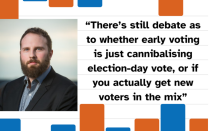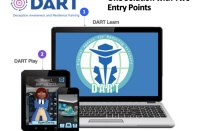Misinformation & Extremism
The title says it all. This will be an interdisciplinary panel discussion about the relationship between mis-/dis-information and extremism and their impacts on our Buffalo community.
Moderator:
Yotam Ophir studies media effects, persuasion, misinformation, conspiracy theories and extremism. His work combines computational methods for text mining, network analysis, experiments and surveys to study media content and effects in the areas of political, science, and health communication.
Dr. Ophir is the head of the Media Effects, Misinformation, and Extremism (MEME) lab at the University at Buffalo, a member of the Center for Information Integrity (CII) at the University at Buffalo, and a distinguished fellow at the Annenberg Public Policy Center at the University of Pennsylvania
Panelists:

Lindsay Hahn’s research focuses on understanding the cognitive processes surrounding media influence in audiences across the lifespan. Taking an approach rooted in evolutionary psychology, Dr. Hahn investigates how exposure to entertainment and news media can shape the extent to which people make judgments and/or adopt behaviors that might be considered beneficial or detrimental to themselves or society. She is particularly interested in examining these processes in socially important populations, leading her work to uniquely focus on the role of entertainment media as a contributing factor in children’s moral and self-centered behaviors and, separately, the extent to which appeals to morality can be an effective tool for radicalizing individuals to join or act on behalf of violent extremist groups.
Hahn directs the Media Psychology and Morality Lab at UB. She is also an affiliate with the Center for the Science of Moral Understanding.

Matt Kenyon is a new media sculptor who lives and works in Buffalo, N.Y. His studio, S.W.A.M.P. (Studies of Work Atmospheres and Mass Production) focuses on critical themes addressing the effects of global corporate operations, mass media and communication, military- industrial complexes, and general meditations on the liminal area between life and artificial life.
Kenyon’s work has been exhibited internationally and collected by institutions including the Museum of Modern Art in New York. It has received a number of awards including the distinguished FILE Prix Lux Art prize. Reproductions of SWAMP’s work have been featured in mainstream publications such as Wired and Gizmodo, and also appear in edited volumes such as A Touch of Code (Gestalten Press) and Adversarial Design (MIT Press).
Kenyon is a 2015 TED fellow and a Macdowell fellow. He was recently selected for Coolhunting’s CH25 a showcase of creators and innovators from a broad range of disciplines who are currently working to drive the world forward.

Mark G. Frank is an internationally recognized expert on human nonverbal communication, emotion, and deception. Dr. Frank conducts research and does training on micro expressions of emotion and of the face. His research studies include other nonverbal indicators of deception throughout the rest of the body.
He is the Director of UB’s Communication Science Center research laboratory. Under his guidance, a team of graduate researchers conduct experiments and studies for private and government entities. Frank uses his expertise in communication and psychology to assist law enforcement agencies in monitoring both verbal and nonverbal communication.

Yini Zhang uses computational methods and big data to study social media and political communication. Her current research program centers around three questions: 1) within social media, how people express themselves and interact with each other, 2) as an ecosystem, how social media platforms relate to one another in terms of the flow of information, and 3) beyond social media, what can influence and be influenced by communication and interaction on social media. She also collaborates with experts in other disciplines to pose new questions and develop new methods to advance communication research.




